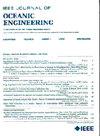基于yolov8的改进浅海生物目标检测方法
IF 5.3
2区 工程技术
Q1 ENGINEERING, CIVIL
引用次数: 0
摘要
随着海洋资源的开发利用,浅海环境下的目标检测变得至关重要。在真实的水下环境中,目标经常受到运动模糊或出现聚类的影响,增加了探测难度。针对这一问题,我们提出了一种改进的基于yolov8的浅海生物目标检测方法。我们通过YOLOv8的两个卷积(C2f)模块将接受场协调注意(RFCA)集成到跨阶段部分瓶颈中,创建了RFCA增强的C2f (C2f_RFCA)。这种增强通过利用多尺度接受场和改进的特征融合策略来改进特征提取和融合,从而更好地检测模糊和遮挡的物体。C2f_RFCA模块捕获局部和全局特征,提高了复杂水下场景下的探测精度。我们还设计了一种改进的动态头,用DCNv3代替可变形ConvNets版本2 (DCNv2),形成DCNv3的动态头。这一升级增加了特征映射的灵活性,并通过允许自适应接受域和增强边界描绘来提高检测密集聚类对象的准确性。为了评估算法的性能,我们在真实的水下目标检测数据集上进行了训练,并在水下目标检测、2020年水下机器人专业比赛和2020年水下目标检测分类数据集上进行了泛化实验。实验结果表明,与YOLOv8n相比,我们的方法在四个数据集上分别提高了mAP@0.5 1.9%、1.7%、4.3%和3.3%,mAP@0.5:0.95提高了2.9%、2.2%、3.8%和5.0%。该方法显著提高了复杂海洋环境中生物的目标检测精度。本文章由计算机程序翻译,如有差异,请以英文原文为准。
An Improved YOLOv8-Based Shallow Sea Creatures Object Detection Method
With the development and utilization of marine resources, object detection in shallow sea environments becomes crucial. In real underwater environments, targets are often affected by motion blur or appear clustered, increasing detection difficulty. To address this problem, we propose an improved YOLOv8-based shallow sea creatures object detection method. We integrate receptive-field coordinate attention (RFCA) into the cross-stage partial bottleneck with the two convolutions (C2f) module of YOLOv8, creating the RFCA-enhanced C2f (C2f_RFCA). This enhancement improves feature extraction and fusion by leveraging multiscale receptive fields and refined feature fusion strategies, enabling better detection of blurred and occluded objects. The C2f_RFCA module captures both local and global features, enhancing detection accuracy in complex underwater scenarios. We additionally devised an improved dynamic head by substituting the deformable ConvNets version two (DCNv2) with DCNv3, forming dynamic head with DCNv3. This upgrade increases the flexibility of feature mapping and improves accuracy in detecting densely clustered objects by allowing adaptive receptive fields and enhancing boundary delineation. To evaluate the algorithm performance, we trained it on real-world underwater object detection data sets and conducted generalization experiments on detecting underwater objects, the underwater robot professional competition 2020 and underwater target detection and classification 2020 data sets. Experimental results show that, compared with YOLOv8n, our method increases mAP@0.5 by 1.9%, 1.7%, 4.3%, and 3.3%, and mAP@0.5:0.95 by 2.9%, 2.2%, 3.8%, and 5.0% in the four data sets. The proposed method significantly improves object detection accuracy for organisms in complex marine environments.
求助全文
通过发布文献求助,成功后即可免费获取论文全文。
去求助
来源期刊

IEEE Journal of Oceanic Engineering
工程技术-工程:大洋
CiteScore
9.60
自引率
12.20%
发文量
86
审稿时长
12 months
期刊介绍:
The IEEE Journal of Oceanic Engineering (ISSN 0364-9059) is the online-only quarterly publication of the IEEE Oceanic Engineering Society (IEEE OES). The scope of the Journal is the field of interest of the IEEE OES, which encompasses all aspects of science, engineering, and technology that address research, development, and operations pertaining to all bodies of water. This includes the creation of new capabilities and technologies from concept design through prototypes, testing, and operational systems to sense, explore, understand, develop, use, and responsibly manage natural resources.
 求助内容:
求助内容: 应助结果提醒方式:
应助结果提醒方式:


